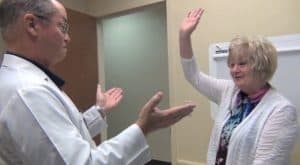What Is a SLAP Tear?
- What Are the Symptoms of a SLAP Tear?
- What Are SLAP Tear Treatment Options?
- How Can an Arthroscopy Help Treat a SLAP Tear?
- What Is the SLAP Tear Repair Recovery Process Like?
Pamela, a recent patient of Alan W. Christensen, M.D., a board-certified
A superior labrum anterior and posterior (SLAP) tear is an injury to the labrum of the shoulder. The labrum is the ring of cartilage that surrounds the socket of the shoulder joint that helps to deepen the socket and stabilize the shoulder joint.
A SLAP tear can be caused by a motor vehicle accident, falling onto an outstretched arm, shoulder dislocation, repetitive overhead sports, or repetitive motions over time. Most SLAP tears are caused by the slowly wearing down of labrum over time.
Pamela, a recent patient of Alan W. Christensen, M.D., a board-certified orthopedic surgeon specializing in hand and upper extremity surgery, says getting treatment for her SLAP tear is one of the best things she has ever done.
“It has been amazing,” says Pamela who has had two shoulder surgeries ten years apart under the care of Dr. Christensen. “There has been very little medication; recovery time has been practically nothing, and everything has been great.”
In 2004, Pamela had surgery to repair a SLAP tear. Over time, she began suffering from pain again and returned to Dr. Christensen for further treatment. With a decade of medical advances between procedures, she says the experience and recovery, this time, was far superior to her last surgery.
What Are the Symptoms of a SLAP Tear?
Imagine cooking in your kitchen, going to reach for something out of a cabinet and not being able to grab it because of excruciating pain in your shoulder. That’s what patients experiencing a superior labrum anterior and posterior (SLAP) tear must live with every day.
“When a SLAP tear occurs, the top part of the labrum becomes unstable and can lead to shoulder instability,” Dr. Christensen says. “The injury tears both the front and back of where the bicep meets the labrum, which can cause a lot of pain for a patient, even if the shoulder does not become unstable it can impair everyday function.”
Symptoms of a SLAP tear include:
- A locking, popping, catching or grinding sensation
- Pain when lifting objects
- Decreased range of motion
- Feeling as if the shoulder is going to pop out of joint
Pamela says she couldn’t move her arm without being in pain before her surgery, but now she has full motion back within just six weeks time.
What Are SLAP Tear Treatment Options?

Pamela has had two shoulder surgeries ten years apart under the care of Dr. Christensen and she says she is back to full function and feels amazing following her latest SLAP tear procedure.
Slap tears are first treated conservatively, meaning surgery is not the first option. Patients and physicians will work together to develop a plan involving medication and physical therapy depending on the severity of the injury. When those conservative measures fail, surgery becomes the only way to repair the tear.
Pamela has had two shoulder surgeries ten years apart under the care of Dr. Christensen, and she says she is back to full function and feels amazing following her latest procedure.
How Can an Arthroscopy Help Treat a SLAP Tear?
A surgical option that a surgeon will most likely use to treat a SLAP tear is an arthroscopy. During an arthroscopy, the surgeon inserts a small camera, called an arthroscope, into the shoulder joint to see what damage has been caused to the shoulder. From there, surgeons can diagnose and repair problems to a joint.
“The arthroscope provides us with a minimally invasive, state-of-the-art method to see inside the joint,” Dr.Christensen says. “Once in the joint, we can repair or remove the torn section of the labrum.”
In the case of Pamela, Dr. Christensen used the arthroscope to repair the labrum and remove three bone spurs that had developed as a result of a 2004 surgery in the same shoulder.
Dr. Christensen used a nerve block to manage pain for Pamela during and after the surgery. “We use this short-term block, which usually lasts several days, to dull the pain for patients following surgery. This minimizes discomfort and allows them to start rehabilitation sooner,” says Dr. Christensen.
“It didn’t even hurt when he put the [nerve] block in,” says Pamela. “I didn’t even know he was finished yet.”
What Is the SLAP Tear Repair Recovery Process Like?
Once the pain and swelling from surgery have diminished, your surgeon will prescribe a physical therapy protocol. Recovery time is anywhere from two to 12 weeks depending on the severity of the injury.
“The last time when I had [surgery] in 2004, I couldn’t even start moving my arm for at least eight weeks,” Pamela says. “This time, my first visit back in one week, I started my therapy doing my strengthening of my arm, moving around, doing all the activities at home.”
After six weeks Pamela has regained full range of motion and she says she couldn’t be happier with the results. “It’s really simple. I wouldn’t go anywhere else. That’s why I came back ten years later,” she says. “I’ve lived through it twice and can say, don’t wait for it – don’t be in pain.”



